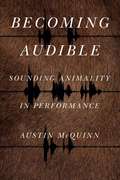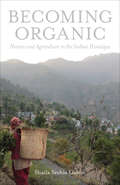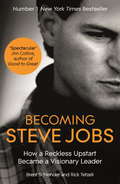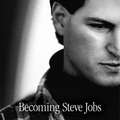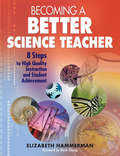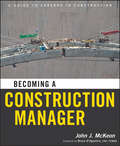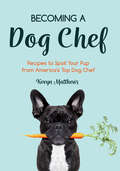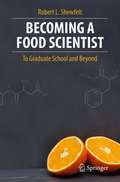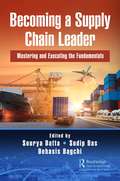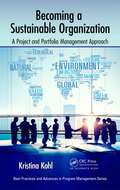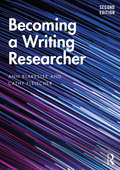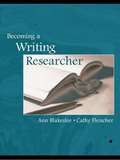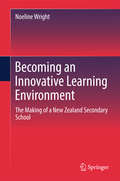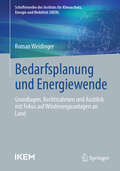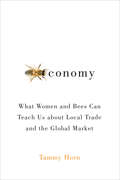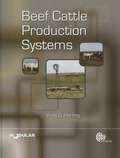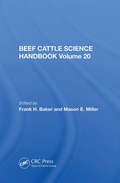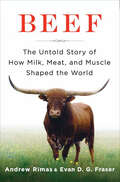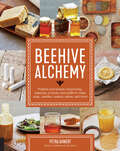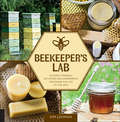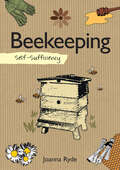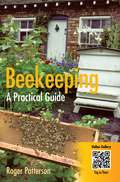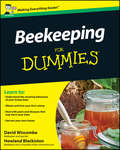- Table View
- List View
Becoming Audible: Sounding Animality in Performance (Animalibus: Of Animals and Cultures #18)
by Austin McQuinnBecoming Audible explores the phenomenon of human and animal acoustic entanglements in art and performance practices. Focusing on the work of artists who get into the spaces between species, Austin McQuinn discovers that sounding animality secures a vital connection to the creatural.To frame his analysis, McQuinn employs Gilles Deleuze and Félix Guattari’s concept of becoming-animal, Donna Haraway’s definitions of multispecies becoming-with, and Mladen Dolar’s ideas of voice-as-object. McQuinn considers birdsong in the work of Beatrice Harrison, Olivier Messiaen, Céleste Boursier-Mougenot, Daniela Cattivelli, and Marcus Coates; the voice of the canine as a sacrificial lab animal in the operatic work of Alexander Raskatov; hierarchies of vocalization in human-simian cultural coevolution in theatrical adaptations of Franz Kafka and Eugene O’Neill; and the acoustic exchanges among hybrid human-animal creations in Harrison Birtwistle’s opera The Minotaur. Inspired by the operatic voice and drawing from work in art and performance studies, animal studies, zooarchaeology, social and cultural anthropology, and philosophy, McQuinn demonstrates that sounding animality in performance resonates "through the labyrinths of the cultural and the creatural," not only across species but also beyond the limits of the human.Timely and provocative, this volume outlines new methods of unsettling human exceptionalism during a period of urgent reevaluation of interspecies relations. Students and scholars of human-animal studies, performance studies, and art historians working at the nexus of human and animal will find McQuinn’s book enlightening and edifying.
Becoming Biosubjects
by Neil Gerlach Rebecca Sullivan Priscilla Walton Sheryl HamiltonBecoming Biosubjects examines the ways in which the Canadian government, media, courts, and everyday Canadians are making sense of the challenges being posed by biotechnologies. The authors argue that the human body is now being understood as something that is fluid and without fixed meaning. This has significant implications both for how we understand ourselves and how we see our relationships with other forms of life.Focusing on four major issues, the authors examine the ways in which genetic technologies are shaping criminal justice practices, how policies on reproductive technologies have shifted in response to biotechnologies, the debates surrounding the patenting of higher life forms, and the Canadian (and global) response to bioterrorism. Regulatory strategies in government and the courts are continually evolving and are affected by changing public perceptions of scientific knowledge. The legal and cultural shifts outlined in Becoming Biosubjects call into question what it means to be a Canadian, a citizen, and a human being.
Becoming Organic: Nature and Agriculture in the Indian Himalaya (Yale Agrarian Studies Series)
by Shaila Seshia GalvinA rich, original study of the social and bureaucratic life of organic quality that challenges assumptions of what organic means Shaila Seshia Galvin examines certified organic agriculture in India&’s central Himalayas, revealing how the fraught concept of organic is less a material property of land or its produce than a quality produced in discursive, regulatory, and affective registers. Becoming Organic is a nuanced account of development practice in rural India, as it has unfolded through complex relationships forged among state authorities, private corporations, and new agrarian intermediaries.
Becoming Steve Jobs: The evolution of a reckless upstart into a visionary leader
by Brent Schlender Rick TetzeliTHE SUNDAY TIMES AND #1 INTERNATIONAL BESTSELLER - with a new foreword by Silicon Valley legend Marc Andreessen.'For my money, a better book about Jobs than Walter Isaacson's biography' New Yorker'A fascinating reinterpretation of the Steve Jobs story' Sunday TimesWe all think we know who Steve Jobs was, what made him tick, and what made him succeed. Yet the single most important question about him has never been answered. The young, impulsive, egotistical genius was ousted in the mid-80s from the company he founded, exiled from his own kingdom and cast into the wilderness. Yet he returned a decade later to transform the ailing Apple into the most successful company the world had ever seen. How did this reckless upstart transform himself into a visionary business leader? The first comprehensive study of Jobs' career following his dismissal from Apple, written with unparalleled access and insight, BECOMING STEVE JOBS offers a startling new portrait of the most important business figure in modern history. The most intimate biography yet of Jobs, written by the journalist who knew him better than any other, BECOMING STEVE JOBS draws on recently discovered interviews that have never before seen the light of day, and answers for the first time the most pressing questions about what made this legendary business leader such a success.
Becoming Steve Jobs: The evolution of a reckless upstart into a visionary leader
by Brent Schlender Rick TetzeliWe all think we know who Steve Jobs was, what made him tick, and what made him succeed. Yet the single most important question about him has never been answered. The young, impulsive, egotistical genius was ousted in the mid-80s from the company he founded, exiled from his own kingdom and cast into the wilderness. Yet he returned a decade later to transform the ailing Apple into the most successful company the world had ever seen. How did this reckless upstart transform himself into a visionary business leader? The first comprehensive study of Jobs' career following his dismissal from Apple, written with unparalleled access and insight, BECOMING STEVE JOBS offers a startling new portrait of the most important business figure in modern history. The most intimate biography yet of Jobs, written by the journalist who knew him better than any other, BECOMING STEVE JOBS draws on recently discovered interviews that have never before seen the light of day, and answers for the first time the most pressing questions about what made this legendary business leader such a success.'Brent Schlender and Rick Tetzeli render a spectacular service with this book, giving fresh perspective on Steve Jobs' journey from inspiring but immature entrepreneur into an inspired and mature company-builder. Most important, they capture Jobs' resilience, his refusal to capitulate, his restless drive to stay in the game, his voracious appetite to learn-this, far more than genius, is what made him great. Becoming Steve Jobs gets the focus precisely right: not as a success story, but as a growth story. Riveting, insightful, uplifting-read it and learn!' Jim Collins, author of Good to Great'BECOMING STEVE JOBS is fantastic. After working with Steve for over 25 years, I feel this book captures with great insight the growth and complexity of a truly extraordinary person. I hope that it will be recognized as the definitive history.' Ed Catmull, President, Pixar and Disney Animation (P)2015 Hodder & Stoughton
Becoming a Better Science Teacher: 8 Steps to High Quality Instruction and Student Achievement
by Elizabeth HammermanThe author provides teacher-friendly tools, insights, sample lessons, and strategies for delivering quality, standards-based science curriculum and instruction that ensures student achievement.
Becoming a Construction Manager
by John J. Mckeon Bruce D'AgostinoThe must-have guide for anyone considering a career in construction managementBecoming a Construction Manager explains everything a person needs to know to become a Construction Manager--from formal education to getting their first job. This practical guide is packed with useful information for anyone considering or beginning a career in construction management, as well as professional construction managers seeking to work in a specific area. From schedule and cost management to sustainability and technology implementation, all of the important career choices are explained by successful construction managers at top international firms.The only guide available on careers in this fast-growing fieldOffers practical guidance in a concise, easy-to-use format, illustrated throughoutIn-depth profiles with construction managers of varying specialties give students and new architects an inside view of the real-world, day-to-day experiences of a working builderIncludes interviewing tips and up to date information on where the jobs are in the field, along with an extensive resource section on professional organizations and educational opportunitiesIntroduction by Bruce D'Agostino, President and CEO of the Construction Management Association of AmericaProviding an overview of the profession, educational requirements, specialties, and the job search, this is a one-stop resource that supplies the inside track on this rapidly growing profession.
Becoming a Dog Chef: Recipes to Spoil Your Pup from America's Top Dog Chef
by Kevyn MatthewsHomemade Dog Food for the Goodest Boys#1 New Release in Animal HusbandryMake your own dog food with world renowned dog chef, Kevyn Matthews. With tons of recipes for canine cooking, these healthy alternatives to processed dog food transform any home into a personal restaurant for dogs.Haute cuisine for hounds. Whether you’re cooking up doggy dinners or puppy picnics, these healthy, homemade dog foods are sure to keep your dog away from the dinner table. With the help of the canine culinary master dubbed “The Dog Chef,” you’ll learn to make your own dog food and create fully balanced meals. Plus, you’ll get an inside look into the life of a dog chef along the way.Wholesome meals for man’s best friend. Chef Kevyn understands that the goodest boys deserve the goodest food. That’s why he’s jam-packed this cookbook with fresh meals and treats that even humans love. Alongside famous one-of-a-kind dog recipes, find bonus information on your dog’s immune system, digestion, and daily life for optimal doggo health.Inside, read chapters on: Raw foodCooked foodTreats and sweetsIf you’re ready to start your own restaurant for dogs, and enjoyed books like Feed Your Best Friend Better, Home Cooking for Your Dog, and Yin & Yang Nutrition for Dogs, then you’ll love Becoming a Dog Chef.
Becoming a Food Scientist: To Graduate School and Beyond
by Robert L. ShewfeltBecoming a Food Scientist is designed as a reservoir of ideas for those beginning a graduate education in food science or beginning a professional career in the field. Although at times it may read as a how-to manual for success in graduate school, it is meant to encourage each reader to study the research process, to challenge conventional wisdom, and to develop a career path that maximizes the probability of success both in school and beyond. The author has viewed food science graduate programs through the lenses of programs at four universities and service in numerous activities with the Institute of Food Technologists. This book is thus focused on the field of food science, but it may have relevance to other scientific disciplines. The book introduces the concept of research as process in the first chapter. Subsequent chapters focus on individual unit operations of research: idea generation, problem definition, critical evaluation of the literature, method selection, experimental design, data collection, processing and analysis, and knowledge dissemination. Successful graduate students in food science must master each of these operations. The final section of the book pushes the reader beyond graduate school into its practice in the real world. Topics covered in the maturation of a food scientist include the scientific meeting, critical thinking, science and philosophy, ethics, finding and managing the literature, planning, grantsmanship, laboratory setup and management, and career development. This book should be a meaningful companion for any graduate student in the field and those transitioning from graduate school to the food science profession.
Becoming a Supply Chain Leader: Mastering and Executing the Fundamentals
by Sourya DattaThe book explains how to emerge and grow as a supply chain leader and details supply chain and procurement processes and operational activities in real-work scenarios across multiple supply chain verticals. The book defines what an entry-level supply chain professional must do to excel in various types of supply chain verticals such as IT, electronics manufacturing, pharmaceutical, retail, and consumer goods. Apart from helping professionals understand vertical specific nuances, this book helps them to set both short-term goals for annual performance review and longer-term career planning. In addition, for a mid- or senior-level supply chain professional, the book offers ideas on ways to launch initiatives and demonstrate leadership to foster career growth. It offers ideas about unlocking new values for the organization and creating a data-driven decision support platform to gain financial efficiency for better management of CapEx and OpEx spend, thus improving the bottom line. The book includes a tool kit which includes operational data models, financial models, and presentation templates for creating and socializing proposals intended for cross-functional teams and demonstrating supply chain leadership. The book is divided into four major parts. In Part I, the book starts with an overview of key concepts in a manufacturing supply chain and procurement organization. It describes current forms of modern global supply chain and corporate procurement organizations. The objective of Part II is to provide a framework for a self-directed supply chain manager to understand how a large organization evaluates the contribution of supply chain managers and where it expects them to create value. To foster career growth as a supply chain professional, the book identifies six key knowledge pillars for demonstrating supply chain mastery: Technical and market knowledge of the end product and its constituents. Knowledge of internal product development and sustaining processes and supporting consumption data. Health and market condition of the supplier. Ability to create value. Ability to build internal and external executive relationships with key influencers. Ability to obtain best cost without compromising on quality and lead time. Negotiating cost, sourcing material, and then the logistics of moving the raw material through multiple stages and finally finished materials across the globe are some of the key areas which need continuous improvement. As a sentinel of efficiency, removing any kind of wastage leads to immediate value creation and contributes to the margin by improving the bottom line. In Part III, the book reviews twelve such verticals namely printer, medical, IT, energy, automotive, cloud, dairy, data management, avionics, biotech, apparel and start up and the supply chain nuances through the lenses of the framework created in Part II. In Part IV, the book goes back to focus on the professional growth of an individual supply chain person in an industry agnostic way. It provides examples of financial and operational efficiencies that a supply chain professional can create.
Becoming a Sustainable Organization: A Project and Portfolio Management Approach (Best Practices in Portfolio, Program, and Project Management)
by Kristina KohlOrganizations find that a performance gap exists between sustainability vision and benefits realization. Effecting transformational change requires incorporating sustainability into organization's culture including policies, processes, and people. Although they are often overlooked, project management professionals and HR professionals are valuable
Becoming a Writing Researcher
by Cathy Fleischer Ann BlakesleeBecoming a Writing Researcher effectively guides students through the stages of conducting qualitative writing research, from the initial step of seeing themselves as researchers, to identifying research questions, selecting appropriate methodological tools, conducting the research, and interpreting and reporting findings. Exercises and activities, as well as anecdotes and examples from both novice and seasoned researchers, serve to acquaint readers thoroughly with the practice of carrying out research for scholarly or professional purposes. This second edition introduces students to research methods in a gradual and contextualized manner. Each chapter offers a discussion of a particular portion of the research process, followed by consideration of physical, conceptual, and strategic tools that allow a master’s level researcher to conduct that part of the research. Sections within each chapter also cover issues of stance and positionality that impact the researcher and the resulting research. Becoming a Writing Researcher, second edition, is an essential text for all novice researchers and is particularly well suited for use in graduate-level research methods courses in writing studies and technical communications. It is also ideal for use in other disciplines with strong qualitative methodology research programs, including education.
Becoming a Writing Researcher
by Ann M. Blakeslee Cathy FleischerBecoming a Writing Researcher effectively guides students through the stages of conducting qualitative writing research, from the initial step of seeing themselves as researchers, to identifying research questions, selecting appropriate tools, conducting the research, and interpreting and reporting the findings. Authors Ann M. Blakeslee and Cathy Fleischer describe various qualitative methods and provide readers with examples of real-world applications. Exercises and activities, as well as anecdotes from both novice and seasoned researchers, serve to acquaint readers thoroughly with the practice of carrying out research for scholarly or professional purposes. The textbook introduces students to research methods in a gradual and contextualized manner. Each chapter opens with a discussion of general issues regarding a particular portion of the research process, followed by a consideration of the various physical, conceptual, and strategic tools that allow a beginning researcher to conduct that part of the process. Sections within each chapter also cover: personal and theoretical perspectives and biases that influence specific stages of the research process ethical issues associated with phases of the research process the identity, ethos, and experiences of the researcher. Becoming a Writing Researcher is an essential text for all novice researchers, and is well suited for use in graduate-level research methods courses in composition and technical communication. It is also ideal for use in other disciplines with strong qualitative methodology research programs, including education.
Becoming an Innovative Learning Environment: The Making of a New Zealand Secondary School
by Noeline WrightThis book traces how a new school, physically designed as a modern learning environment, has come into being in New Zealand. A key feature is how it designs its curriculum for future citizens. The book explores how flexible curriculum and assessment options support the provision of a well-balanced, coherent and future-oriented learning programme. It also illustrates how the school is implementing its vision and copes with being different from other schools which understand and embody the New Zealand Curriculum as well as the NCEA qualifications system in more traditional terms. School leaders’, teachers’ and foundation students’ thinking and perspectives about what it’s like to become a new school are highlighted and shed light on what is possible within an evolving education system.
Bedarfsplanung und Energiewende: Grundlagen, Rechtsrahmen und Ausblick mit Fokus auf Windenergieanlagen an Land (Schriftenreihe des Instituts für Klimaschutz, Energie und Mobilität)
by Roman WeidingerDieses Buch bietet eine ausführliche Untersuchung zu staatlicher Bedarfsplanung im Gefüge verfassungsrechtlicher Anforderungen und praktischer Anwendung. Insbesondere bereitet es erstmals monographisch die neueren Entwicklungen der Windenergieflächenbedarfsplanung auf. Hierbei werden zum einen die planungsrechtlichen Aspekte für Windenergieanlagen an Land umfassend aufgearbeitet und noch offene rechtswissenschaftliche Fragen in diesem Bereich diskutiert und einer Klärung zugeführt. Zum anderen wird die hochaktuelle gesetzgeberische Konzeption des Windenergieflächenbedarfsgesetzes umfassend erläutert, rechtlich geprüft und funktionsbezogen analysiert und bewertet. Schließlich macht die Arbeit auf Grundlage dieser Erkenntnisse, insbesondere der Neuartigen Aspekte der Flächenbedarfsplanung, rechtspolitische Vorschläge, wie die (Flächen-)Bedarfsplanung im Zusammenhang der Energiewende weiter an Bedeutung gewinnen könnte. Sie leistet damit einen wesentlichen Beitrag zur rechtstheoretischen und rechtsdogmatischen Einordnung der Bedarfsplanung insgesamt und liefert eine umfassende Analyse der bisherigen planungsrechtlichen Dogmatik für Windenergieanlagen an Land. Die rechtspolitischen Vorschläge treffen auf einen rechtlichen Bereich mit hoher Entwicklungsdynamik, sodass sie nicht nur mittel- und lang-, sondern schon kurzfristig für Wissenschaft und Politik von Nutzen sein können. Dementsprechend liegt die Zielgruppe vor allem in der Wissenschaft, insbesondere rechtspolitisch arbeitenden Wissenschafter:innen im Bereich des Energie- und vor allem Planungsrechts, sowie in der Politik - hier vor allem Entscheidungsträger in Regierung und Parlamenten sowie Interessenverbände im Bereich der Energiewende. Die rechtsdogmatischen Ausführungen, gerade zu planungsrechtlichen Rahmenbedingungen für Windenergieanlagen an Land, sind ferner auch an Praktiker gerichtet.
Beeconomy: What Women and Bees Can Teach Us about Local Trade and the Global Market
by Tammy HornA fascinating study that &“opens a window on the world of beekeeping and female beekeepers&” (Lexington Herald-Leader). From Africa to Australia to Asia, women have participated in the pragmatic aspects of honey hunting and in the more advanced skills associated with beekeeping as hive technology has progressed through the centuries. Who are the women who keep bees and what can we learn from them? Beeconomy examines the fascinating evolution of the relationship between women and bees around the world. Bee expert Tammy Horn profiles female beekeepers, describing their work and how they manage it; the sense of community they enjoy; how beekeeping is relevant to questions about globalization and politics—and how it provides an opportunity for a new sustainable economy, one that takes into consideration environment, children, and family needs.
Beef Cattle Production Systems
by Andy HerringThis textbook provides an integrated view of beef cattle production with a systems based approach, discussing the interrelationships of a broad range of aspects with the overall goal of optimising cattle production. This book provides the background to allow cattle producers to match their production environments with genetic, management, and marketing opportunities for sustainable beef production globally. This logic and resulting considerations can then be tailored to address specific regional challenges and opportunities worldwide. Considerations and examples for extreme situations will be provided, such as very small herds, very large herds, communal-group situations, and minimal artificial input systems. This practical book will be important reading for upper level undergraduate and postgraduate students in animal and veterinary science, producers, extension workers and veterinarians.
Beef Cattle Science Handbook, Vol. 20
by Frank H. BakerThe 1984 International Stockmen's School Handbooks include more than 200 technical papers presented at this year's Stockmen's School, sponsored by Winrock International. The authors of these papers are outstanding animal scientists, agribusiness leaders, and livestock producers who are expert in animal technology, animal management, and gene
Beef: The Untold Story of How Milk, Meat, and Muscle Shaped the World
by Andrew Rimas Evan D. FraserThe cow. The most industrious animal in the world. A beast central to human existence since time began, it has played a vital role in our history not only as a source of food, but also as a means of labor, an economic resource, an inspiration for art, and even as a religious icon. Prehistoric people painted it on cave walls; explorers, merchants, and landowners traded it as currency; many cultures worshipped it as a god. So how did it come to occupy the sorry state it does today—more factory product than animal?In Beef, Andrew Rimas and Evan D. G. Fraser answer that question, telling the story of cattle in its entirety. From the powerful auroch, a now extinct beast once revered as a mystical totem, to the dairy cows of seventeenth-century Holland to the frozen meat patties and growth hormones of today, the authors deliver an engaging panoramic view of the cow's long and colorful history.Peppered with lively anecdotes, recipes, and culinary tidbits, Beef tells a story that spans the globe, from ancient Mediterranean bullfighting rings to the rugged grazing grounds of eighteenth-century England, from the quiet farms of Japan's Kobe beef cows to crowded American stockyards to remote villages in East Africa, home of the Masai, a society to which cattle mean everything. Leaving no stone unturned in its exploration of the cow's legacy, the narrative serves not only as a compelling story but as a call to arms, offering practical solutions for confronting the current condition of the wasteful beef and dairy industries. Beef is a captivating history of an animal whose relationship with humanity has shaped the world as we know it, and readers will never look at steak the same way again.
Beehive Alchemy: Projects and Recipes Using Honey, Beeswax, Propolis, and Pollen to Make Soap, Candles, Creams, Salves, and More
by Petra AhnertA comprehensive introduction to making candles, home and body products life from the author of Beeswax Alchemy.Beehive Alchemy is a continuation of Petra Ahnert’s bestselling Beeswax Alchemy. With this new book, beekeepers (and bee lovers) will learn about the benefits and attributes of beeswax, honey, propolis, and more alongside a full range of projects and techniques to process and harness the amazing gifts of bees. Inside, you’ll find instructions to make Ahnert’s award-winning hand-dipped birthday candles, the classic French dessert canele bordelais, and much more, including:Alchemy for the BodyLiquid soap with honeyBeard balmOlive and honey lotionAlchemy of LightTaper candlesTea lightsPillarsAlchemy for the HomeFurniture polishWaxed cotton food wrapsWoodcutter incenseAlchemy in the StudioBeeswax crayonsEncausticBatikAlchemy in the KitchenCookies and candiesBeveragesFermentationsWhether you keep bees or just love them, Beehive Alchemy will become your go-to comprehensive guide for hive-to-home creations.Praise for Beeswax Alchemy:“An excellent introduction and solid technique instruction to make candles, lotions, and soaps with beeswax. . . . The true strength of this book is its instructions for making homemade body products. While similar in coverage to Leeann Coleman and Jayne Barnes’s Honey Crafting, Ahnert’s book provides better body products and more detailed technical instruction. Strongly recommended.” —Library Journal“This is the book I’ve been waiting for. Excellent instructions. Bountiful information. Beautifully done.” —Kim Flottum, author of The Backyard Beekeeper and editor of Bee Culture magazine
Beekeeper's Lab: 52 Family-Friendly Activities and Experiments Exploring the Life of the Hive
by Kim Lehman"Very informative and fun . . . Science, art, bee care, 52 different labs to entertain, delight, educate and inspire everyone in your family." —A Net in TimeBeekeeping's popularity as a hobby continues to skyrocket. And now, with Beekeeper's Lab, you can fill the year ahead with weekly activities from around and about the hive—including art projects, recipes, experiments, garden activities, and more!Bees are important to local ecosystems,now more than ever. Whether you're already a beekeeper, or are still considering getting your first hive, Beekeeper's Lab has projects perfect for you. This extensive guide book features 52 beekeeping and hive-inspired projects to keep you involved with your buzzing friends all year long.The tutorials are brief, accomplishable, rewarding, and best of all, they are presented in afriendly lab-style format. Try a new technique each weekwith how-tos and sidebars with tips that are perfect for the whole family. Beekeeping is a fun hobby to enjoy, plus, who doesn't want their own supply of honey?
Beekeeping (Self-Sufficiency)
by Joanna RydeLearn what all the buzz is about with this guide to the fascinating and sustainable hobby of keeping bees. Plus: honey recipes for food and skin care!Beekeeping is about management, control and learning to understand the honeybee. It can also become a very enjoyable and sociable pastime—visiting others&’ hives and picking up vital hints and tips is all part of the fun—and farming and eating honey that your own bees have produced is a pure delight. Joanna Ryde covers all aspects of beekeeping, from the basic tools and equipment needed for setting up a hive to detailed advice on when to harvest honey and honey-inspired recipes, from delicious cakes to beauty products. This really is the definitive guide for anyone thinking of keeping bees.
Beekeeping - A Practical Guide: A Practical Guide
by Roger PattersonA practical book for new beekeepers and those interested in keeping their own bees, explaining everything they need to know to get started. It also covers how to make your garden attractive for bees. Published to coincide with the biggest beginners' day for beekeeping which takes place in February each year.
Beekeeping - A Practical Guide: A Practical Guide
by Roger PattersonA practical book for new beekeepers and those interested in keeping their own bees, explaining everything they need to know to get started. It also covers how to make your garden attractive for bees. Published to coincide with the biggest beginners' day for beekeeping which takes place in February each year.
Beekeeping For Dummies
by Howland Blackiston David WiscombeThe fast and easy way to start and maintain a hiveBeekeeping For Dummies is a practical, step-by-step beginner's guide to beekeeping. It gives you plain-English guidance on everything you need to know to start your own beehive, from buying the right equipment, sourcing bees, and locating your hive to maintaining a healthy colony and harvesting honey. Plus, you'll get the latest information on the causes and effects of bee disease, colony collapse disorder, and the impact the sudden disappearance of the honeybee has on our environment and economy.Here, you'll get trusted information on beekeeping in the UK, specifically written to address climate, buying equipment, locating hives, the local impact of colony collapse disorder and ways to avoid or minimise the risk to your hive, seasonal beekeeping tasks, local beekeeping associations, and updated content on urban beekeeping. Understand the anatomy of your bees Learn techniques and tips for harvesting, bottling, packaging, and selling honey Discover the benefits of beekeeping Learn techniques on obtaining and hiving your beesIf you're a beginner beekeeper, taking a beekeeping course, or just have an interest in the plight of the honeybee, Beekeeping For Dummies has you covered!
